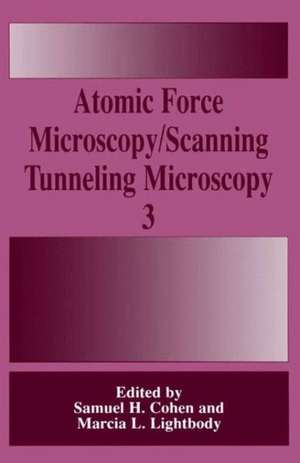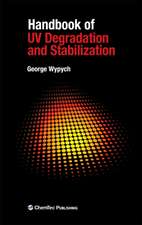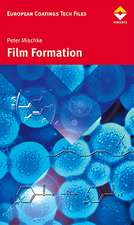Atomic Force Microscopy/Scanning Tunneling Microscopy 3
Editat de Samuel H. Cohen, Marcia L. Lightbodyen Limba Engleză Paperback – 21 mai 2013
| Toate formatele și edițiile | Preț | Express |
|---|---|---|
| Paperback (1) | 943.57 lei 6-8 săpt. | |
| Springer Us – 21 mai 2013 | 943.57 lei 6-8 săpt. | |
| Hardback (1) | 951.29 lei 6-8 săpt. | |
| Springer Us – 30 dec 1999 | 951.29 lei 6-8 săpt. |
Preț: 943.57 lei
Preț vechi: 1150.70 lei
-18% Nou
Puncte Express: 1415
Preț estimativ în valută:
180.61€ • 189.75$ • 151.78£
180.61€ • 189.75$ • 151.78£
Carte tipărită la comandă
Livrare economică 12-26 martie
Preluare comenzi: 021 569.72.76
Specificații
ISBN-13: 9781475781847
ISBN-10: 1475781849
Pagini: 220
Ilustrații: VIII, 210 p. 109 illus.
Dimensiuni: 178 x 254 x 12 mm
Greutate: 0.39 kg
Ediția:2002
Editura: Springer Us
Colecția Springer
Locul publicării:New York, NY, United States
ISBN-10: 1475781849
Pagini: 220
Ilustrații: VIII, 210 p. 109 illus.
Dimensiuni: 178 x 254 x 12 mm
Greutate: 0.39 kg
Ediția:2002
Editura: Springer Us
Colecția Springer
Locul publicării:New York, NY, United States
Public țintă
ResearchDescriere
The Foundation for Advances in Medicine and Science (FAMS), the organizers of SCANNING 98, sponsored its third annual Atomic Force Microscopy/Scanning Tunneling Microscopy Symposium at the Omni Inner Harbor Hotelin Baltimore, Maryland, from May 9 to 12, 1998. This book represents the compilation of papers that were presented at the AFM/STM Symposium as well as a few that were presented at SCANNING 96 and SCANNING 97 meetings that took place in Monterey, California. The purpose of the symposium was to provide an interface between scientists and engineers, representatives of industry, government and academia, all of whom have a common interest in probe microscopies. The meetings offered an ideal forum where ideas could easily be exchanged and where individuals from diverse fields who are on the cutting edge ofprobe microscopy research could communicate with one another. Experts in probe microscopy from around the world representing a wide range of disciplines including physics, biotechnology, nanotechnology, chemistry, material science, etc., were invited to participate. The format of the meeting was structured so as to encourage communication among these individuals. During the first day’s sessions papers were presented on general topics such as application of scanning probe microscopy in materials science; STM and scanning tunneling spectroscopy of organic materials; fractal analysis in AFM; and nanomanipulation. Other papers presented included unexpected ordering of a molecule; synthesis ofpeptides and oligonucleotides; and analysis oflunar soils from Apollo 11.
Cuprins
Preface. Keynote Paper: A Practical Approach to Understanding Surface Metrology and Its Applications; C.A. Brown. Applications of Scanning Probe Microscopy in Materials Science: Examples of Surface Modification and Quantitative Analysis; P. von Blanckenhagen. Scanning Probe Microscopy in Biology with Potential Applications in Forensics; J. Vesenka, E. Morales. Atomic Manipulation of Hydrogen on Hydrogen-Terminated Silicon Surfaces with Scanning Tunneling Microscope; D.H. Huang, Y. Yamamoto. Apollo 11 Lunar Samples: An Examination Using Tapping Mode Atomic Force Microscopy and Other Microscopic Methods; E.C. Hammond, et al. Novel Micromachined Cantilever Sensors for Scanning Near-Field Microscopy; W. Scholz, et al. Imaging of Cell Surface Structure by Scanning Probe Microscopy; V.A. Fedirko, et al. A Force Limitation for Successful Observation of Atomic Defects: Defect Trapping of the Atomic Force Microscopy Tip; I.Y. Sokolov, et al. A New Approach To Examine Interfacial Interaction Potential Between a Thin Solid Film or a Droplet and a Smooth Substrate; R. Mu, et al. Nanometer-Scale Patterning of Surfaces Using Self-Assembly Chemistry. 1. Preliminary Studies of Polyaniline Electrodeposition on Self-Assembled Mixed Monolayers; W.A. Hayes, C. Shannon. Local Rate of Electroless Copper Deposition by Scanning Tunneling Microscopy; C.J. Weber, et al. Atomic Force Microscopy of Olivine; C. Wilson, et al. The Study of Sublimation Rates and Nucleation and Growth of TNT and PETN on Silica and Graphite Surfaces by Optical and Atomic Force Microscopy and Ellipsometry; Y.S. Tung, et al. Peculiarities of the Scanning Tunneling Microscopy Probe on Porous Gallium Phosphide; V.M. Ichizli, et al. Influence of Doping Concentration on The Etching Rate of GaAs Studied by Atomic Force Microscopy; R.S. Freitas, et al.Comparative Scanning Tunneling Microscopy Studies of CoFe2O4 Nanoparticles of Ferrofluids in Acidic Medium; D. Dai, et al. From Laboratory Measurements to the First In-Situ Analysis of Pristine Cometary Grains; J. Romstedt, et al. Synthesis of Prebiotic Peptides and Oligonucleotides on Clay Mineral Surfaces: A Scanning Force Microscopy Study; T.L. Porter, et al. Surface Structure and Intercalative Polymerization Studies of Smectite Clay Thin Films; T.L. Porter, et al. Atomic Force Microscopy &endash; A New and Complementary Tool in Asphalt Research Compared to Scanning Electron Microscopy; L. Loeber, et al. Index.












